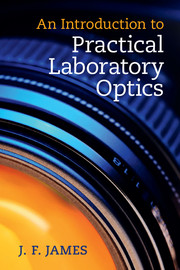Book contents
- Frontmatter
- Contents
- Preface
- 1 Introduction: centred optical systems
- 2 Telescopes and binoculars
- 3 Eyepieces, eyes and colour
- 4 Cameras and camera lenses
- 5 The scientific CCD camera
- 6 Spectrometry
- 7 Interferometers and their uses
- 8 Electro-optical effects and their practical uses
- 9 Microscopes and projectors
- 10 Siderostats and coelostats
- 11 The detection and measurement of radiation
- 12 Practicalities
- Appendix A Gaussian optics
- Appendix B Optical aberrations
- Appendix C A brief introduction to Fourier optics
- Further reading
- Index
11 - The detection and measurement of radiation
Published online by Cambridge University Press: 05 October 2014
- Frontmatter
- Contents
- Preface
- 1 Introduction: centred optical systems
- 2 Telescopes and binoculars
- 3 Eyepieces, eyes and colour
- 4 Cameras and camera lenses
- 5 The scientific CCD camera
- 6 Spectrometry
- 7 Interferometers and their uses
- 8 Electro-optical effects and their practical uses
- 9 Microscopes and projectors
- 10 Siderostats and coelostats
- 11 The detection and measurement of radiation
- 12 Practicalities
- Appendix A Gaussian optics
- Appendix B Optical aberrations
- Appendix C A brief introduction to Fourier optics
- Further reading
- Index
Summary
Which device is to be used to detect radiation depends very much on the kind of radiation. Heat, for example, the far infra-red that is, needs a bolometer; the UVOIR region relies on the interaction of radiation with electric charge, and the far ultra-violet relies on fluorescence or the photoelectric effect.
The geometry of radiation measurement
Two things are fundamental.
(1) There is no power in a parallel beam: power depends on divergence into a finite solid angle.
(2) There is no power from a point source. The power radiated is proportional to the source area if the radiation is incoherent, and is proportional to the square of the source area if the radiation is coherent across the area.
The two useful ideas – a point source and a parallel beam – are, like light rays themselves, among the ‘convenient fictions’ of physics.
Extended sources
As we can see from the remarks above, all sources are extended to some degree. Even a single atom radiates a spectral line from an ‘area’ of about λ2 because you cannot ‘localize’ the emitter to better than this, using this radiation. Light sources then are distinguished by their surface brightness, the power emitted per unit area per unit solid angle.
Information
- Type
- Chapter
- Information
- An Introduction to Practical Laboratory Optics , pp. 130 - 140Publisher: Cambridge University PressPrint publication year: 2014
